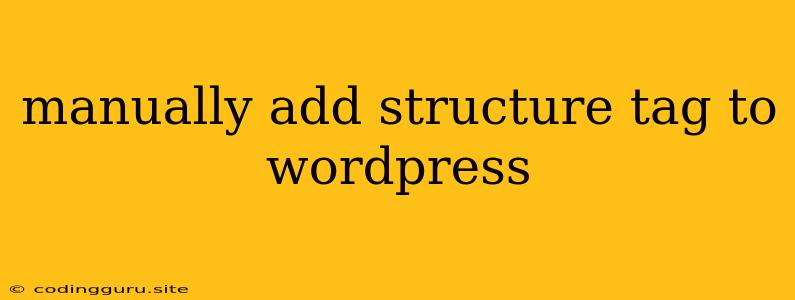Manually Adding Structure Tags to WordPress: Enhancing SEO
WordPress is a powerful platform for building websites, but sometimes you need to go beyond its default settings to optimize your site for search engines. One crucial aspect of SEO is using structure tags, also known as schema markup, to provide search engines with richer information about your content.
While WordPress themes and plugins often include basic schema markup, manually adding structure tags allows you to tailor them precisely to your content and unlock advanced SEO benefits.
Why Manually Add Structure Tags?
- Enhanced Search Engine Visibility: Structure tags help search engines understand the context of your content, resulting in richer snippets and improved search rankings.
- More Detailed Information: They can display additional information about your content, such as product prices, review ratings, or event dates, in search results.
- Increased Click-Through Rates: More detailed search snippets can entice users to click on your listings, leading to increased traffic.
Understanding Structure Tags
Structure tags use a specific vocabulary called Schema.org to define the type of content on your website. Here are some common examples:
- Article: For blog posts and articles.
- Product: For products sold on an e-commerce site.
- Recipe: For recipe websites.
- Event: For events, conferences, or meetings.
- Person: For author profiles or team members.
Manually Adding Structure Tags in WordPress
There are a few ways to manually add structure tags to your WordPress website:
1. Using the WordPress Editor
- Plugins: There are several plugins like Schema App, Yoast SEO, and Rank Math that allow you to add structure tags easily through the WordPress editor. These plugins often provide templates and wizards for generating the correct markup.
- Code Snippets: You can insert the necessary code directly into your WordPress theme files or use a plugin like Insert Headers and Footers to add code to your header or footer.
2. Using a Code Editor
- Directly Editing Theme Files: If you're comfortable working with code, you can edit your theme's header.php file to add structure tags.
- Using a Child Theme: This is recommended if you don't want to modify your original theme files.
3. JSON-LD
JSON-LD (JavaScript Object Notation for Linked Data) is a lightweight format for representing structured data. You can add JSON-LD to your WordPress website using the following methods:
- Head Section: You can include JSON-LD directly in the
<head>section of your website. - Plugin: Plugins like WP Schema and JSON-LD for WP can be used to generate and insert JSON-LD.
Examples of Structure Tags
Here are some basic examples of structure tags:
For an Article:
For a Product:
Tips for Adding Structure Tags
- Use a Schema Validation Tool: Tools like Google's Rich Results Test and Schema.org's validator can help you ensure your tags are correctly implemented.
- Keep It Simple: Start with the most important structure tags for your website. You can always add more later.
- Test and Monitor: Regularly test your structure tags and monitor your search engine performance to see how they're affecting your rankings.
Conclusion
Manually adding structure tags to your WordPress website can significantly enhance your SEO by providing search engines with a deeper understanding of your content. By taking the time to implement schema markup correctly, you can improve your website's visibility and attract more potential customers.
